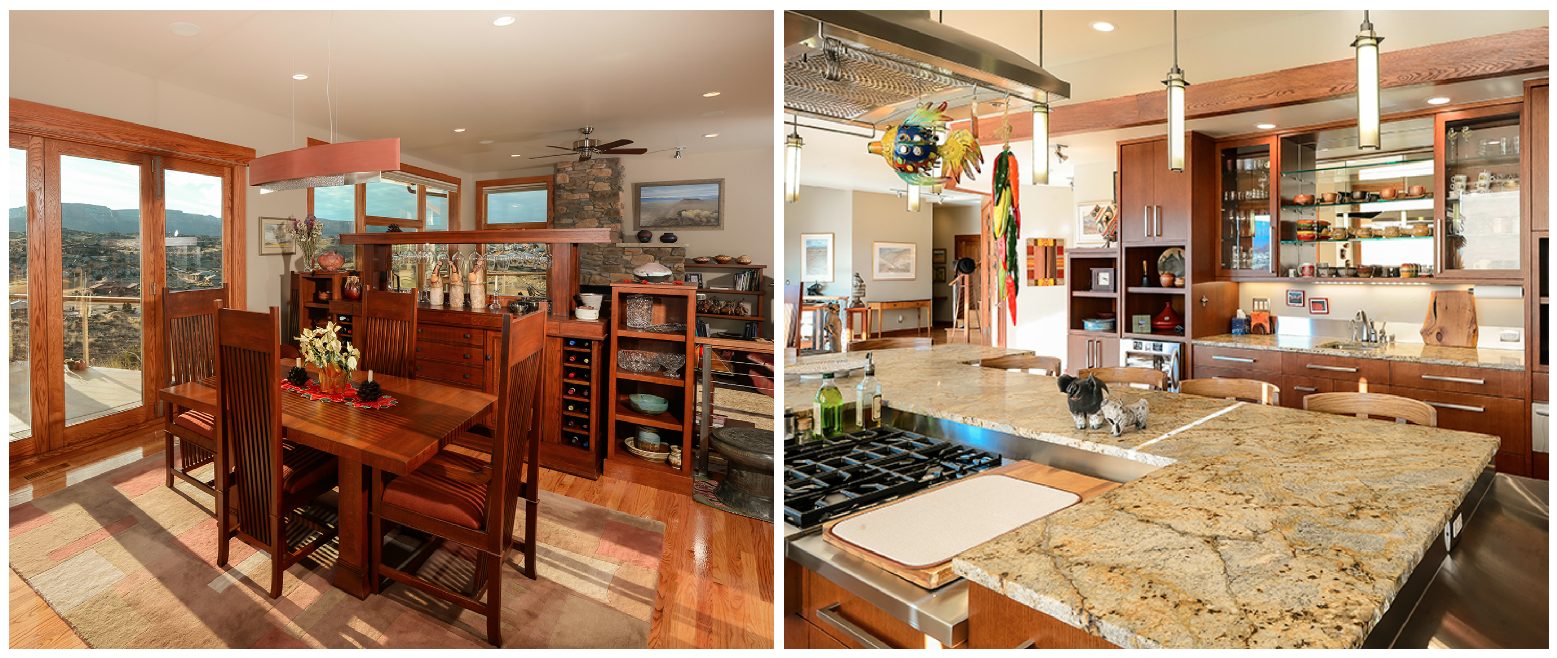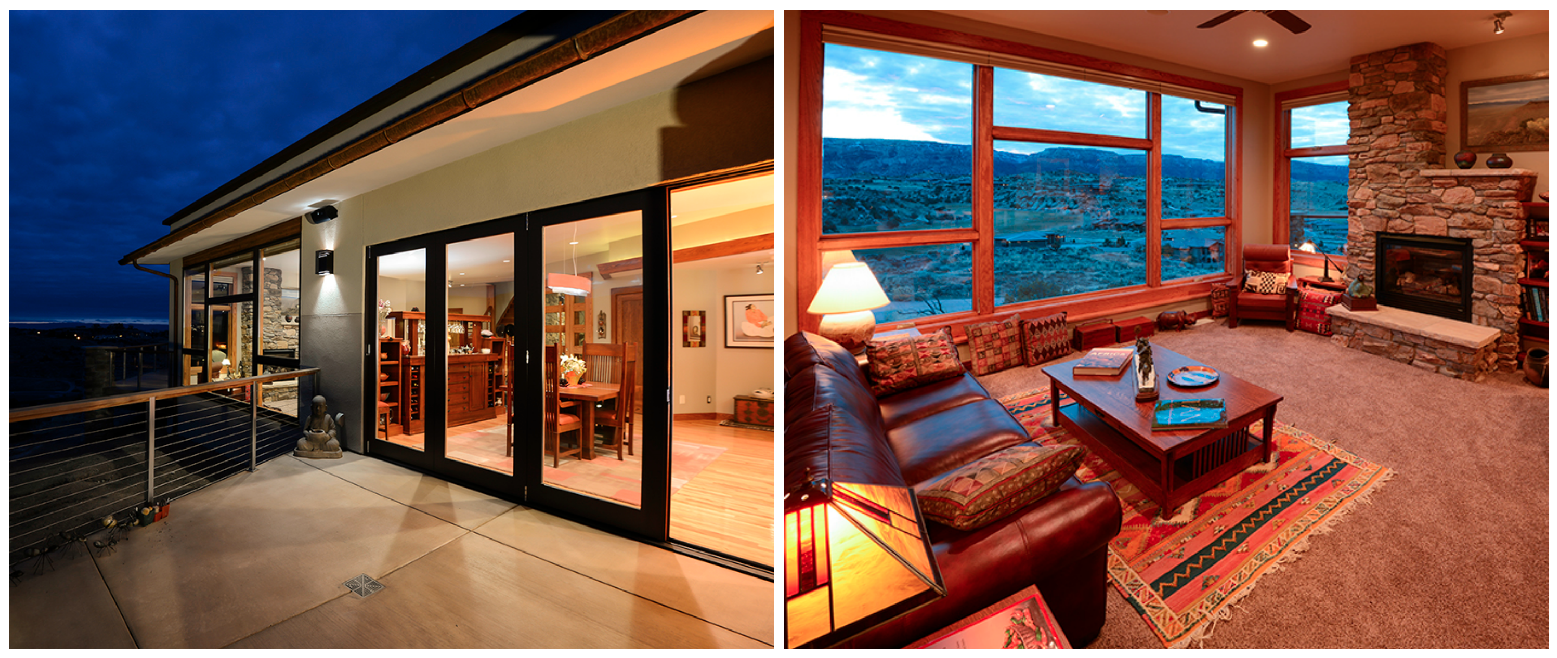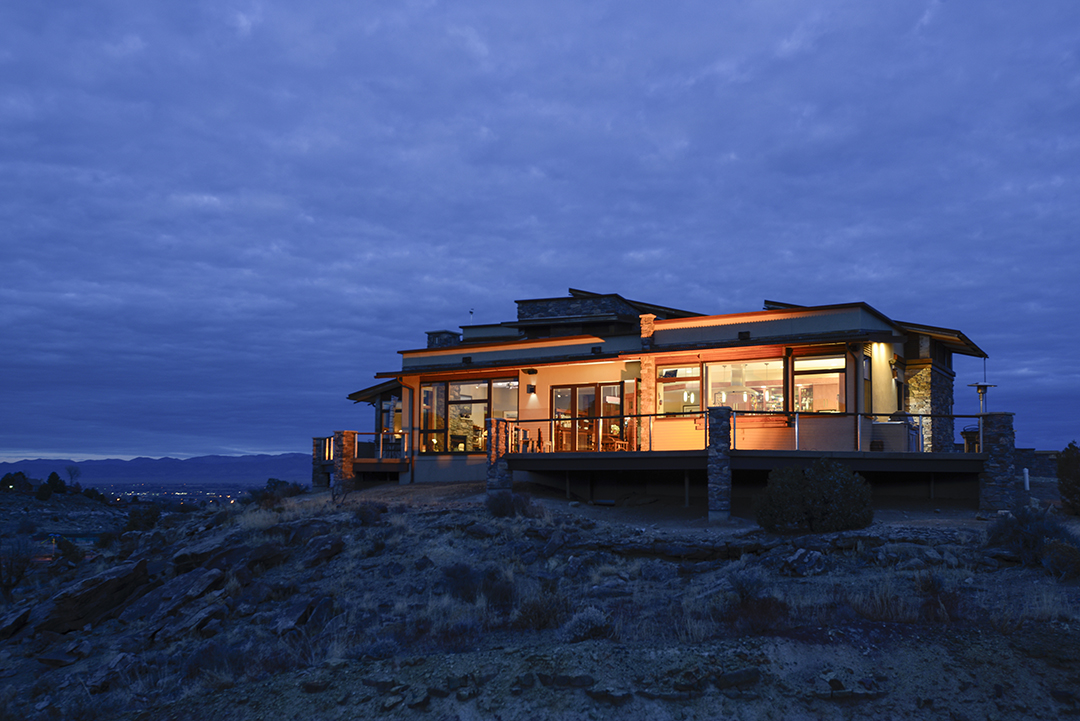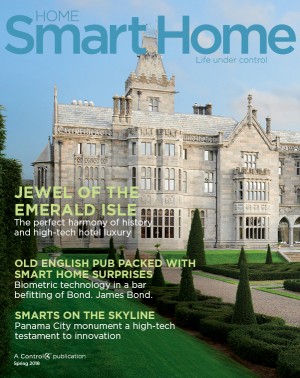A LEVEL ABOVE
By Guest | Posted May 3, 2018ABOVE: The 3,000-square foot “high desert modern” house appears as if it grew out of the hillside. Lots of windows provide sweeping views and help regulate indoor climate with motorized shades.
Home Control and Automation Are True No-Brainers in This “High-Desert Modern” Haven. Hands Aren’t Required, Either.
LOCATION: Grand Junction, Colorado // DEALER: All Sound Designs // PHOTOGRAPHY: Gordon Nicholson
When Gordon and Lay Chin Nicholson roam their 3,000-square-foot home overlooking the mesas near Grand Junction, Colorado, they have their choice of 24 Control4 in-wall lighting keypads with six buttons each. But, because the house is automated to the hilt, they rarely touch them.
As they stroll through the house, lights automatically turn on in the areas they enter, and to their preferences. If it’s the middle of the night, lights illuminate only to dimmed levels, so the couple can find their way around without being blinded—and without touching a thing. “We sometimes go days without touching a switch,” says Gordon.
Depending on where they are in the house, heating and cooling turn on to their pre-set desires automatically and set back to energy-saving levels when they aren’t present or at home. Motorized shades rise and lower according to the time of day to help regulate temperatures inside the house. And a clever whole-house entertainment system delivers music, movies, and TV programming in highly customized ways.
This level of smart automation is possible with a network of sensors, all connected to a Control4 smart home controller and wireless lighting network. Eric Landis, owner of Grand Junction-based All Sound Designs, which specializes in hands-free home technology, reports that 30 tiny sensors help trigger the critical functions of the house—inside and out—without anyone touching a keypad.
PLEASANT SURPRISES
Gordon Nicholson is an engineer by trade and plenty tech savvy, but he never expected the level of smart home sophistication he and Lay Chin now experience every day.
Surprise after surprise faced the Nicholsons, from the moment a bicycle ride up a bluff near Grand Junction revealed the lot for sale— and at a welcoming price. The couple snatched up the land, hired architect Lancer Livermont of Intermountain Architecture in Grand Junction, and began plans. Nicholson wanted his new home to be technologically equipped with home automation but also wanted it to be easy to use and to save a ton of energy. He even had elaborate lighting plans with a full range of flexible control.
Using energy-efficient LED lamps for all of the home’s lighting and automating the climate control made home automation a true no-brainer. But when the Nicholsons met Landis and heard about hands-free lighting, Gordon was skeptical. Then he experienced it for real. “Touring the other home [Eric] had done, we began to get an appreciation going up stairways and through hallways and seeing the lights go on.”
The finished house sits on the brow of a hill with 360-degree views of the high desert, starring the Colorado National Monument and Grand Mesa. Livermont designed the home in what he terms “high desert modern” style, with its contemporary rock-clad and stucco forms appearing as if they had emerged from the mountain. Slanted roofs mimic the slope, and open decks extend to wide-open vistas. The dining room even opens to the outside.
Wood trim adds warmth with Douglas fir ceilings at the entrance and in overhangs, quarter-sawn oak cabinets, hardwood oak flooring, and extra wide oak trim. The tops of the steel cable railings are made from ipe, the Brazilian mahogany-toned hardwood, completing a refined natural feel of a place that folds into and complements its rugged surroundings.

AMBIANCE OF AUTOMATION
Behind the cowboy country views and comfortable modern decor, sensors and timers work in concert with the Control4 system to light, heat, and cool the house, hands- and mind-free.
Fifteen minutes before sunset, the home enters “Evening” mode. The outside lights are programmed to come on and then turn off at 10 p.m. At the same time, a selection of lights in the home also turn on to 20 percent levels to create an “Ambiance” scene throughout the residence, highlighting the couple’s art collection.
The Nicholsons wanted to display art collected from their travels. Glare and the threat of fading from ultraviolet light inspired a gallery that wraps around the walls that frame the staircase, which, of course, lights automatically as one ascends or descends, depending on the time of day
When the home enters “Evening” mode, the motion sensors become active and trigger lights in key pathways and rooms. If no motion is detected after a set time, the pathway lights shut off to conserve energy
After 10 p.m., the house enters “Late Night” mode and any light triggered by a motion sensor comes on at dimmer levels around 10 percent to eliminate the blinding effect.
During the day, most of the lights in the home are not active. Only areas that are naturally dark during the day are active.
When the Nicholsons actually need to touch a lighting keypad, button presses always override automation. “If a light switch in the home is manually turned on, it will come up to full power, even if the light was turned to a dim mode by a motion sensor,” says Landis.
Six centrally-located thermostats rely on temperature sensors in the house and are programmed with set points for different times of day. In-floor heating in the bathrooms turn on for four hours in the morning and four hours in the evening to warm the floors. The thermostats are also regulated by occupancy sensors, so if no one is in a zone for two hours, the thermostat sets back to an energy-saving temperature.
Other big energy savers include the 30 motorized Hunter Douglas shades, programmed to rise and lower at certain times to control solar gain, which can be a hot problem in the high desert summer. The shades on the east side lower in the morning, and those on the west side in the afternoon. In less sunny areas, shades are timed to display the great views during the day and then close after sunset.
 Home and lighting controls are everywhere, but rarely do the homeowners touch a switch or keypad. Sensors trigger automated lighting scenes for energy-efficient LED lamps throughout the home.
Home and lighting controls are everywhere, but rarely do the homeowners touch a switch or keypad. Sensors trigger automated lighting scenes for energy-efficient LED lamps throughout the home.
The window shading and energy-efficient lighting complement the 7kW photovoltaic solar system that provides electricity. Livermont says the Nicholsons have achieved a net gain on their electricity bills in their first year there.
“[The home automation] system perfectly dovetails what we’re doing with design,” says Livermont. “Having control of the interior shading helps manage the passive solar design, and automated lighting controls save on energy consumption.”
In addition, the garage door sensor ties into the security system and a driveway sensor alerts the house to guests arriving with an audible tone over the house-wide audio system.
Entertainment wasn’t left out. Gordon and Lay Chin enjoy his and her music systems over the in-ceiling speakers throughout the house. Apple TVs behind each TV provide video on-demand everywhere without employing a complicated and complex video matrix or switching system. The Apple TVs are fed into the Control4 amplifier, then to the speakers.
The backbone is a pwerful networking system that allows easy roaming throughout the house without losing a Wi-Fi signal. “The unified system creates a nice, smooth umbrella,” says Landis.
All of it, of course, is operable from the Control4 App—even the ceiling fans, fireplace, and outdoor water fountain. Remote access is a prime feature for the couple, who travel a lot but like to check in on the home front. Water and low-temperature sensors can alert them to a problem with leaks or frozen pipes.
“The flexibility of this system is amazing,” says Nicholson by phone, as he checked up on his super-smart home—remotely of course.
FOR MORE SMART HOME STORIES IN DENVER CLICK HERE
Category SMART HOME STORIES Home Control and Automation Are True No-Brainers in This “High-Desert Modern” Haven. Hands Aren’t Required, Either.
LOCATION: Grand Junction, Colorado // DEALER: All Sound Designs // PHOTOGRAPHY: Gordon Nicholson
When Gordon and Lay Chin Nicholson roam their 3,000-square-foot home overlooking the mesas near Grand Junction, Colorado, they have their choice of 24 Control4 in-wall lighting keypads with six buttons each. But, because the house is automated to the hilt, they rarely touch them.
As they stroll through the house, lights automatically turn on in the areas they enter, and to their preferences. If it’s the middle of the night, lights illuminate only to dimmed levels, so the couple can find their way around without being blinded—and without touching a thing. “We sometimes go days without touching a switch,” says Gordon.
Depending on where they are in the house, heating and cooling turn on to their pre-set desires automatically and set back to energy-saving levels when they aren’t present or at home. Motorized shades rise and lower according to the time of day to help regulate temperatures inside the house. And a clever whole-house entertainment system delivers music, movies, and TV programming in highly customized ways.
This level of smart automation is possible with a network of sensors, all connected to a Control4 smart home controller and wireless lighting network. Eric Landis, owner of Grand Junction-based All Sound Designs, which specializes in hands-free home technology, reports that 30 tiny sensors help trigger the critical functions of the house—inside and out—without anyone touching a keypad.
PLEASANT SURPRISES
Gordon Nicholson is an engineer by trade and plenty tech savvy, but he never expected the level of smart home sophistication he and Lay Chin now experience every day.
Surprise after surprise faced the Nicholsons, from the moment a bicycle ride up a bluff near Grand Junction revealed the lot for sale— and at a welcoming price. The couple snatched up the land, hired architect Lancer Livermont of Intermountain Architecture in Grand Junction, and began plans. Nicholson wanted his new home to be technologically equipped with home automation but also wanted it to be easy to use and to save a ton of energy. He even had elaborate lighting plans with a full range of flexible control.
Using energy-efficient LED lamps for all of the home’s lighting and automating the climate control made home automation a true no-brainer. But when the Nicholsons met Landis and heard about hands-free lighting, Gordon was skeptical. Then he experienced it for real. “Touring the other home [Eric] had done, we began to get an appreciation going up stairways and through hallways and seeing the lights go on.”
The finished house sits on the brow of a hill with 360-degree views of the high desert, starring the Colorado National Monument and Grand Mesa. Livermont designed the home in what he terms “high desert modern” style, with its contemporary rock-clad and stucco forms appearing as if they had emerged from the mountain. Slanted roofs mimic the slope, and open decks extend to wide-open vistas. The dining room even opens to the outside.
Wood trim adds warmth with Douglas fir ceilings at the entrance and in overhangs, quarter-sawn oak cabinets, hardwood oak flooring, and extra wide oak trim. The tops of the steel cable railings are made from ipe, the Brazilian mahogany-toned hardwood, completing a refined natural feel of a place that folds into and complements its rugged surroundings.
AMBIANCE OF AUTOMATION
Behind the cowboy country views and comfortable modern decor, sensors and timers work in concert with the Control4 system to light, heat, and cool the house, hands- and mind-free.
Fifteen minutes before sunset, the home enters “Evening” mode. The outside lights are programmed to come on and then turn off at 10 p.m. At the same time, a selection of lights in the home also turn on to 20 percent levels to create an “Ambiance” scene throughout the residence, highlighting the couple’s art collection.
The Nicholsons wanted to display art collected from their travels. Glare and the threat of fading from ultraviolet light inspired a gallery that wraps around the walls that frame the staircase, which, of course, lights automatically as one ascends or descends, depending on the time of day
When the home enters “Evening” mode, the motion sensors become active and trigger lights in key pathways and rooms. If no motion is detected after a set time, the pathway lights shut off to conserve energy
After 10 p.m., the house enters “Late Night” mode and any light triggered by a motion sensor comes on at dimmer levels around 10 percent to eliminate the blinding effect.
During the day, most of the lights in the home are not active. Only areas that are naturally dark during the day are active.
When the Nicholsons actually need to touch a lighting keypad, button presses always override automation. “If a light switch in the home is manually turned on, it will come up to full power, even if the light was turned to a dim mode by a motion sensor,” says Landis.
Six centrally-located thermostats rely on temperature sensors in the house and are programmed with set points for different times of day. In-floor heating in the bathrooms turn on for four hours in the morning and four hours in the evening to warm the floors. The thermostats are also regulated by occupancy sensors, so if no one is in a zone for two hours, the thermostat sets back to an energy-saving temperature.
Other big energy savers include the 30 motorized Hunter Douglas shades, programmed to rise and lower at certain times to control solar gain, which can be a hot problem in the high desert summer. The shades on the east side lower in the morning, and those on the west side in the afternoon. In less sunny areas, shades are timed to display the great views during the day and then close after sunset.
The window shading and energy-efficient lighting complement the 7kW photovoltaic solar system that provides electricity. Livermont says the Nicholsons have achieved a net gain on their electricity bills in their first year there.
“[The home automation] system perfectly dovetails what we’re doing with design,” says Livermont. “Having control of the interior shading helps manage the passive solar design, and automated lighting controls save on energy consumption.”
In addition, the garage door sensor ties into the security system and a driveway sensor alerts the house to guests arriving with an audible tone over the house-wide audio system.
Entertainment wasn’t left out. Gordon and Lay Chin enjoy his and her music systems over the in-ceiling speakers throughout the house. Apple TVs behind each TV provide video on-demand everywhere without employing a complicated and complex video matrix or switching system. The Apple TVs are fed into the Control4 amplifier, then to the speakers.
The backbone is a pwerful networking system that allows easy roaming throughout the house without losing a Wi-Fi signal. “The unified system creates a nice, smooth umbrella,” says Landis.
All of it, of course, is operable from the Control4 App—even the ceiling fans, fireplace, and outdoor water fountain. Remote access is a prime feature for the couple, who travel a lot but like to check in on the home front. Water and low-temperature sensors can alert them to a problem with leaks or frozen pipes.
“The flexibility of this system is amazing,” says Nicholson by phone, as he checked up on his super-smart home—remotely of course.
FOR MORE SMART HOME STORIES IN DENVER CLICK HERE

